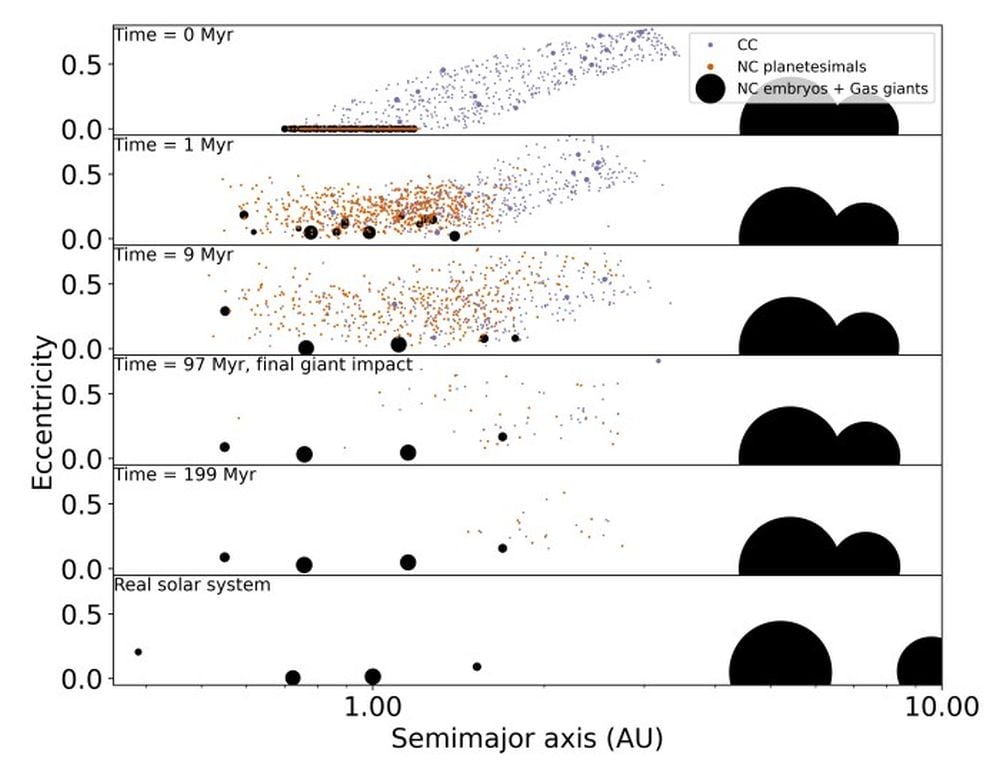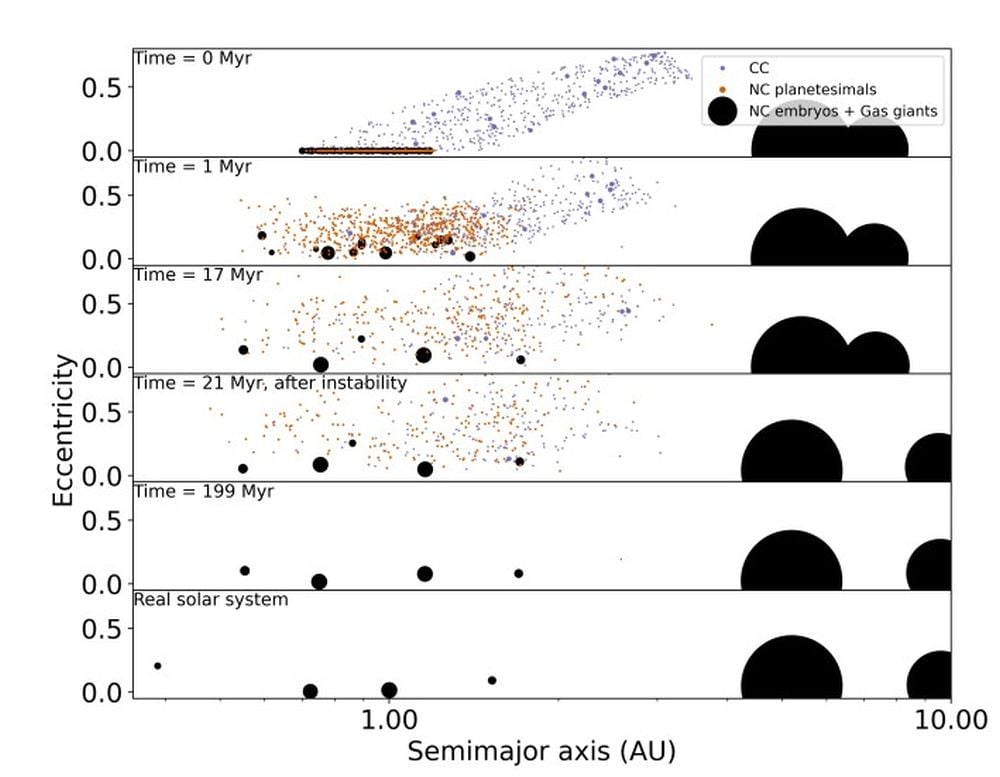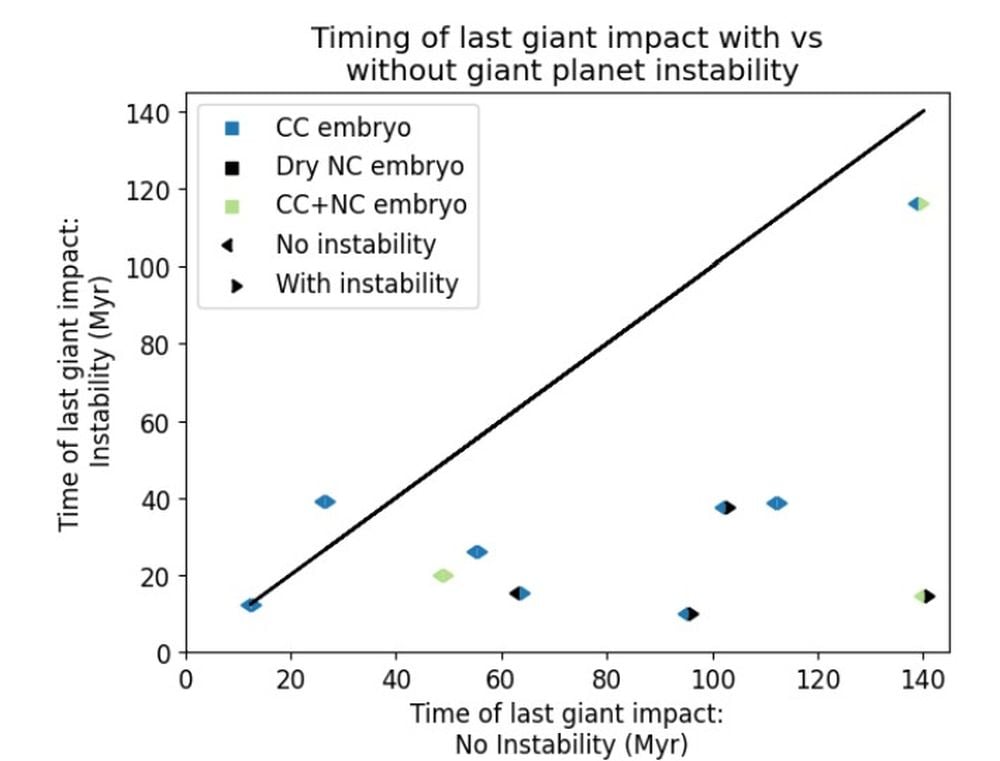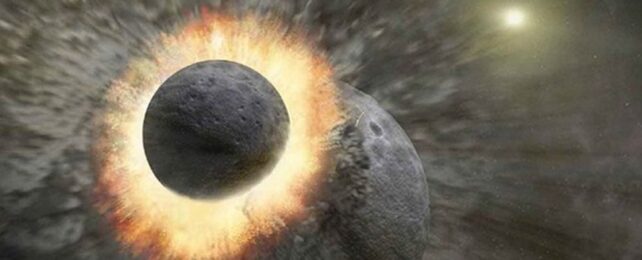How did Earth, alone among the Solar System's rocky planets, become the home for life? How, among all this frigid lifelessness, did our planet become warm, hospitable, and life-sustaining?
The answer to these questions is complex and multi-faceted, and part of the answer comes from cosmochemistry, an interdisciplinary field that examines how chemical elements are distributed.
The Solar System is a busy place where everything is in motion. It was even more chaotic 4.5 billion years ago, with planets still forming and planetesimals and planetary embryos whizzing around and crashing into one another.
Somehow, in all that chaos, Earth received more than its share of carbonaceous chondrites and the amino acids and other life-enabling chemicals that came with them.
Related: We May Have Finally Found a Chunk of Theia Buried Deep Inside The Moon
Cosmochemistry studies have shown that between 5% and 10% of Earth's mass came from carbonaceous chondrites that crashed into the young planet. Studies also show that a large chunk of that came from the Theia impactor that created the Moon.
To test these ideas more rigorously, a trio of researchers used dynamical simulations of the Solar System's formation to see if they could replicate it.
The research is titled "Dynamical origin of Theia, the last giant impactor on Earth." The lead author is Duarte Branco from the Institute of Astrophysics and Space Sciences at the Lisbon Astronomical Observatory in Portugal. The research will be published in the journal Icarus.
One of the critical distinctions in cosmochemistry is the difference between carbonaceous chondrites (CCs) and non-carbonaceous meteorites (NCs). It divides the Solar System's meteor population into two groups and suggests that the Solar System contains two distinct reservoirs of material.
CCs formed further from the Sun, likely beyond Jupiter, and carry more volatiles like water and organic compounds with them. NCs include things like iron meteorites, and contain fewer volatiles.
In order to test the idea that Theia delivered CCs and volatiles to Earth, the researchers ran detailed simulations of the Solar System. These were N-body simulations of the later stages of the growth of terrestrial planets.
The simulations began in the late stages of planetary growth after the Solar System's gaseous disk was dispersed. The available solid mass was divided into planetesimals and planetary embryos.
The simulation included CCs that were scattered inward as Jupiter and Saturn were still growing and accreting matter. Because of the size distinction between planetesimal and planetary embryos, embryos have a higher possibility of interacting with the terrestrial planets and delivering CC material.
The researchers ran three types of simulations. The first they call small only and includes only small CC objects, or planetesimals. The second they call large only and includes only large CC objects, planetary embryos. The third includes both CC planetesimals and embryos and is called the mixed scenario.
For a subset of 10 simulations from each of those scenarios, they included the effect of the giant planet dynamical instability. This is known as the "Nice model" in astronomy and describes how the giant planets shifted their orbits from where they initially formed.
The goal was to determine how CCs and NCs were distributed in the Solar System and to understand how Earth ended up with more CCs than the other rocky planets, especially Mars. The researchers also wanted to understand if the Theia impact could be responsible for delivering a large amount of Earth's CC material.
One clear result is that the role of giant planet instability, especially Jupiter's shift to a different orbit, had a pronounced effect on Earth's accretion of CC material.

When the researchers added giant planet dynamical instability, things looked even more interesting. "The giant planet instability dramatically changed the evolution of the system causing a strong pulse of eccentricity excitement, which lead to a wave of collisions and ejections," the authors write. However, the final state of the system didn't change much.

A critical part of the simulations concerns the Theia impactor. Previous research suggests that Theia may have been a carbonaceous object. If that's true, much of Earth's life-giving habitability may have resulted from that collision.
"In the mixed scenario with no giant planet instability, Earth's final impactor included a CC component in more than half of all simulations. In 38.5% of simulations, the final impactor was a pure CC embryo, and in another 13.5%, the impactor was an NC embryo that had previously accreted a CC embryo," the researchers write.
Overall, the simulations paint a picture of the early Solar System where two distinct rings of planetesimals. An inner ring consisting of rocky planetesimals and an outer ring of carbonaceous chondrites.
Later, as the ice giants migrated inward, they propelled CC material into the inner Solar System. Some of these were trapped in the asteroid belt, while more massive ones were preferentially scattered into the orbits of the rocky planets.
"The late-stage accretion of the terrestrial planets involved a series of giant impacts between NC embryos and planetesimals, with occasional impacts of CC objects," the authors explain.
This scenario explains several things about the Solar System. It explains the masses and orbits of the terrestrial planets, and the orbital distribution of asteroids. It also matches the CC mass fraction of Earth and Mars, where Mars lacks the same concentrations of CC material as Earth.
If the small only simulation were correct, where CC material was only in the form of planetesimals, the CC mass fraction of Mars and Earth would be roughly the same.

The researchers set out to show that, in line with other research, Theia could've been Earth's final large impactor and that it contained ample CC material. They appear to have succeeded.
In the simulations, Earth's final giant impact was with Theia, and that object had higher concentrations of CC material which helped make Earth habitable. That result is in line with scientific thinking.
The work shows that the last impact was after between 5 to 150 million years after gas dispersal. A large fraction of those were within 20 to 70 million years. There are uncertainties in the timing of the Theia impact and these results work within those.
The simulations also support other conclusions showing that CC embryos and planetesimals could've been accreted throughout Earth's growth, but were concentrated in later phases of growth.
"Within the context of this scenario, the last giant impactor on Earth contained a CC component in roughly half of all of the mixed simulations," the authors write.
"In the majority of these (38% of simulations), Theia was a pristine CC embryo, and in the remainder of cases Theia was an NC embryo that had previously accreted a CC embryo."
The research also shows that Jupiter played an important role in the Solar System's architecture. It not only truncates the asteroid belt, but played an important role in determining the final composition of the terrestrial planets by scattering CC material from the outer Solar System into the path of the rocky planets, especially Earth.
A million things had to be just right for Earth to become the life-sustaining world it is today. How likely it is that there are other worlds out there like it is unknown. It may take more than being in a habitable zone for an exoplanet to support life.
There may be a bewildering number of variables that have to go right, including outer giant planets that migrate and deliver carbon to rocky worlds in habitable zones.
This article was originally published by Universe Today. Read the original article.
